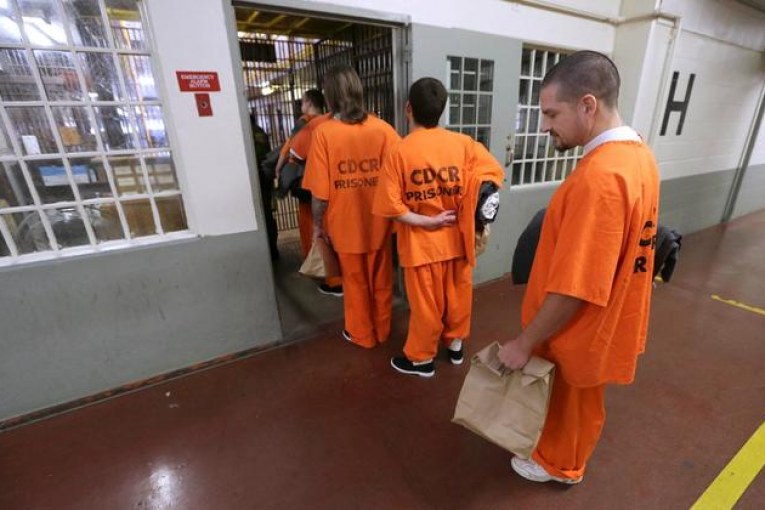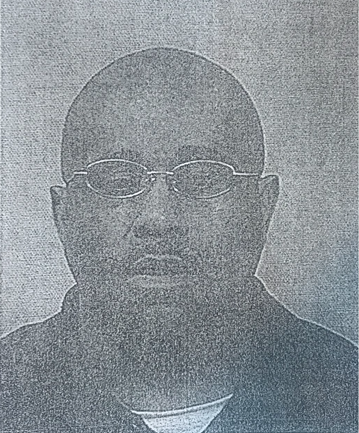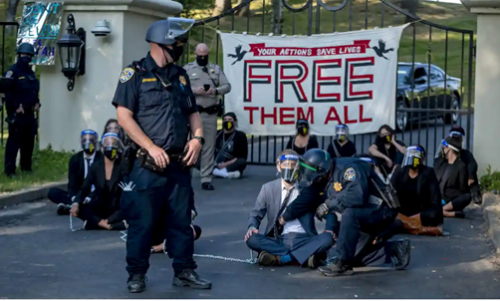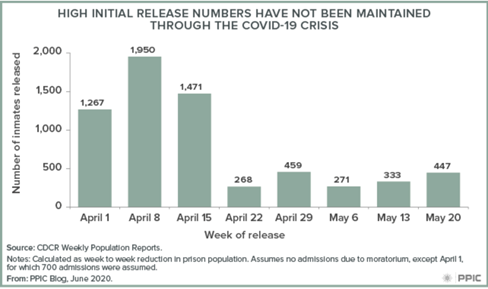
By Yasmeen Khan
This report is written by the Covid In-Custody Project — an independent journalism project that partners with the Davis Vanguard to bring reporting on the pandemic in California’s county jails and Department of Corrections and Rehabilitation (CDCR) to the public eye. Visit our website to view and download raw data on cases, testing, releases and vaccinations.
The COVID-19 pandemic has devastated the entire world with loss, change, and isolation.
But as issues of testing, restriction tiers, and vaccine distribution have consumed public attention, incarcerated people in prisons and county jails remain an overlooked cohort despite contracting the virus at a rate five times higher than the United States population at-large.
In California, the CA Department of Corrections and Rehabilitation (CDCR) manages 35 state prisons and a total population of 97,000 people. During the pandemic, the prison administration came under heavy scrutiny as critics argued that it was failing to safeguard the health of incarcerated people. While protocols such as sanitation and masking were implemented with some success, no amount of precaution could defeat the impact of overcrowding. Social distancing became an oxymoron in facilities that have beds less than 3 ft. apart.
Consequently, massive outbreaks plagued CDCR facilities throughout 2020– nearly 50,000 total cases were recorded and 224 people died from COVID-related complications. Some facilities reported positivity rates of 30-40 percent at the peak of the outbreaks.
Several lawyers and advocates for prison reform have argued that the pandemic’s deadliness was exacerbated by CDCR’s failure to reduce its population enough. Population reduction, they argue, would allow for social distancing and protect high risk individuals from being exposed to the virus.
CDCR implemented a range of policies and programs aimed at reducing prison populations throughout 2020. However, many lawyers and advocates held that these were simply not enough. Through the following initiatives, the overall CDCR prison population fell by approximately 22 percent:
- Halt on intake from California’s county jail system
Beginning in March 2020, the CDCR stopped accepting individuals slated for state facilities from county jails. Limited jail intake resumed on May 25, 2020. It was shortly halted once again on June 19 and resumed on Aug. 24. While the prison population significantly reduced due to this policy, over 8,000 individuals in county jails were awaiting transfer to state facilities by Oct. 2020. - Early release for some people with 180 days or less to serve and housed at any prison
Program is on-going. In order to be eligible, individuals must not be currently serving time for domestic violence, or a violent or serious crime as defined by law, have no current or prior sentences that require them to register as a sex offender under Penal Code 290, not have a California Static Risk Assessment (CSRA) score indicating a high risk for violence, and must submit to COVID-19 testing. As of January 2021, CDCR reported 6,833 people were released under this program. - Early release for some with one year or less to serve, or who have served their base term, and are at high risk for medical complications if infected with COVID-19 Program is on-going. Eligible individuals include those who are not serving time for domestic violence or a violent crime, have no current or prior sentences that require them to register as a sex offender, and do not have a CSRA score indicating a high risk for violence. 1,690 people qualified for this program and as of January 2021 553 were reviewed.
- Early release consideration for some age 65 or above or with medical conditions that create an especially high risk of serious complications if infected with COVID-19
Program ended in October 2020. Eligible individuals included those with a weighted COVID-19 risk score of four points or higher. CDCR claims that 6,599 people were eligible for consideration, however only 1,335 were ultimately considered. Of these, only 60 people were granted early release. A spokesperson for the department stated that many individuals who were eligible may have been released via programs 2, 3 or 4. - Positive Programming Credit (12 Weeks of Time Credit)
CDCR gave 12 weeks of credit to individuals with no rules violations between March 1, 2020 and July 5, 2020 to compensate for the loss of credits due to COVID-related suspensions in education, vocational training, counseling, etc. Those serving life without the possibility of parole or who are condemned were exempt. CDCR stated that “these credits will be coded under the existing Extraordinary Conduct Credit, which allows the Director of the Division of Adult Institutions to award credit to an inmate who has ‘provided exceptional assistance in maintaining the safety and security of a prison.’”
Of these initiatives, program 4 has received significant attention and criticism from decarceration advocates. At the time of its suspension, less than one percent of eligible individuals had been granted expedited release. 99.1 percent of highly vulnerable individuals in CDCR custody were left seeking refuge from overcrowded conditions that could have turned their time in prison into a death sentence.
Chancellor Wade is one of these high risk individuals who applied for early release while at Folsom State Prison (FSP) to no avail. He has a COVID risk score of 4 out of 5, and meets all the eligibility criteria under program 4. Wade says that the overcrowded and unsanitary conditions urgently necessitated the release of more individuals like himself.

“Prisons like San Quentin and FSP were built in the 1800s when they didn’t have infectious disease control in mind. They were building a way to put the maximum number of people in the sardine can and said ‘let’s roll with it’,” Wade remarked during an interview with the Vanguard.
More than half of the FSP’s population has been infected and two individuals have died.
In Wade’s experience, the CDCR’s COVID high risk point system designed to assess an individual’s medical vulnerability and eligibility for early release, did not fairly or adequately measure someone’s high risk status.
“In my opinion they did something very legally impermissible and life threatening, they assigned a point system to each high risk medical condition. For example asthma is one point. Immunocompromisation is assigned a point value of two. It’s only when the point value system totals up to 4 that you’re considered high risk. But the CDC doesn’t say that, they say having one of those points alone and in and of itself makes someone at high risk,” Wade said.
Wade’s petition against the Secretary of the CDCR, also calls out the lack of accessibility and transparency in the early release application process.
“These arbitrary acts are done to dramatically reduce the number of prison residents of this cohort who will be eligible for expedited release. How else can it be reasonably explained that approximately 9,000 medically high risk prison residents from this cohort group have been identified by Respondents but approximately only 60 have received expedited release?”
According to UC Hastings law professor Hadar Aviram, misguided eligibility requirements are largely to blame for the less-than-ideal decarceration progress. In her blog Aviram recognizes the political barriers impeding large-scale early release. Notably, decisions to free once-violent individuals, such as San Quentin’s “Clawhammer Killer” Ivan Von Staich, are especially susceptible to sensational press and public outrage.
In a recent Vanguard Webinar: A Human Rights Disaster at San Quentin, Aviram calls out public misapprehension surrounding early releases, “A 65 year old man with a bullet in his lung, I happen to describe the petitioner Ivon Von Staich, is much more dangerous to you inside incubating the virus, getting you and yours sick, than they are outside with their families. There is a vast amount of people behind bars who have long ago aged out of crime.”
Many victims rights groups have expressed their concern for their safety, and call for their specific needs and concerns of victims to be upheld throughout the early release process.
The Victims’ Rights and Services Coalition argues that eligibility for early release should entail, “an examination of any history of violent acts of the inmate to determine release, instead of simply using the “violent” or “nonviolent” classification alone to release individuals.”
Similarly, many district attorneys worry that mass releases will compromise public safety. Sacramento DA Anne Marie Schubert argued, “Allowing the early release of the most dangerous criminals, shortening sentences as much as 50%, impacts crime victims and creates a serious public safety risk.”
But according to a 2014 study from the Southern California Law Review, no correlation exists between the nature of a crime and recidivism. “The emphasis on non-non-nons might have been tailored to obtain public buy-in,” Aviram states. “But it stubbornly evades dealing with the most obvious category of people for release: folks doing life with parole for a crime (obviously violent) committed decades ago.”
Chancellor Wade also suspects political rather than public safety oriented decisions with the CDCR’s approach to early release.
He adds, “There hasn’t been enough done. Primarily I believe as it has always been for political reasons…they are concerned by what certain people in the community such as victims rights groups may say, and consequently when it comes to voting they may suffer at the polls. I also believe there are economic reasons, they get state dollars for each head.”
While political backlash and public safety remained a primary concern for early release efforts, the Vanguard previously reported that out of all COVID-related deaths, “139 people or 91 percent had ‘low’ CSRA scores, meaning they were low-risk to reoffend based on their age, gender and offense if released into the community. Only 2 people or 1.3 percent had ‘high’ CSRA scores.”
- Average age of those who have died: 63
- 75 percent of those who have died had disabilities (including mental health disabilities or ADA disabilities)
- 70 percent POC
- 40 percent Hispanic
- 25 percent Black
Wade also highlights the lack of transparency and due process rights that incarcerated individuals are given throughout their early release application process.
“The way they set it up, it violates the California State constitution procedural due process requirements. They don’t give you notice. They don’t tell individuals in here what their total COVID risk score is. Then sometimes they’ll reduce your COVID risk score to take you out of the range of being eligible for release, without even bringing you before a doctor to justify removing a medical condition that reduces your score. So what’s your medical justification for reducing the score,” Wade asks.
Wade adds, “There are due process requirements in the California Constitution that require that they adhere to anytime there’s a protected liberty interest at stake, and release from prison is a liberty interest that should be protected.”
In addition to CDCR’s actions, Gov. Newsom, who was under pressure to exercise clemency powers as California’s executive, awarded multiple pardons to a select group of well-vetted individuals. As of March 2021, he has granted 72 pardons, 79 commutations and 20 reprieves.
But Gov. Newsom’s clemency— a tedious and politically risky prerogative— fails to satisfy the scope of early release needs. With both state and CDCR action deemed “insufficient,” activists have begun to propose their own early-release plans that they view to be more effective.
The Californians United for a Responsible Budget (CURB) implemented “The People’s Plans for Prison Closure,” which seeks to close at least 10 state prisons in an effort to take on a more permanent solution to preventing health crises in prisons.
Amber-Rose Howard, the Executive Director of CURB asserts, “CDCR’s current prison closure discussion is missing the voices of people with the most at stake and who are best positioned to lead these decisions: currently incarcerated people…”

In light of UCSF’s urgent memo recommending “that the prison population at San Quentin be reduced to 50% of current capacity via decarceration,” Wade states that FSP necessitates the same reduction as both facilities have similar conditions.
“Folsom State prison is similarly situated by comparable analysis to San Quentin. They are built identically the same. There may be variances. But it is inconsequential in relation to the material similarities for purposes of this urgent memo. And specifically, in relation to the adverse effects, if and when the next infectious disease outbreak were to occur, as predicted by infectious disease experts,” Wade explains.
Wade’s main assertion is that the CDCR is not doing enough if de-crowding is not at the center of their COVID response efforts,
“Despite all those preventive measures that the CDCR lists on their website, they are all ineffective if the missing ingredient of reducing the prison population does not reach 50% or more.”
While the CDCR faced challenges with congestion, county jails in California have been dealing with population issues of their own.
According to the Prison Policy Initiative, trends from across the country show that during 2020, population reduction in county jails came as a result of increasing releases rather than fewer admissions.
In California, this has been achieved through modified bail schedules and early-releases for qualifying individuals.
In March 2020, courts across the state adopted a zero-bail policy to reduce the number of pre-trial detainees being held in custody. Further, several Sheriff’s Offices encouraged booking agencies to cite and release as many offenders as possible, instead of bringing them into custody.
During the beginning of the pandemic jails managed to significantly reduce their populations, however data shows that this trend is now reversing.

On the contrary, prisons managed to reduce their populations by 22 percent largely due to reduced admissions and not releases. This measure was dependent on halting country intake and came at the expense of straining jail capacity.
Local Sheriff’s Offices argue that CDCR pushed the problem of overcrowding onto the county correctional system by halting intake for the majority of 2020. In Santa Rita Jail, Alameda County, nearly 300 individuals have been pending transfer to state facilities since August 2020. While SRJ’s population declined sharply at the beginning of the pandemic, it has been on an upward trajectory since then. The jail administration attributes this surge to CDCR’s halt on intake.
CDCR has recognized the burden jails have faced with as a result of their halts on jail intakes, “in recognition of those challenges, the Administration identified $31.2 million in state General Fund last year to reimburse county jails, with CDCR paying a per diem of $93.54 per inmate.”
While reducing admissions to prison is certainly a right step in mitigating overcrowding, experts argue that it is not a long-term solution. This shifted the debate surrounding release authority to federal and state courts, as they faced increasing pressure to implement mass release orders.
The civil lawsuit Plata v. Newsom regarding inadequate medical and mental health services for incarcerated individuals, set an important precedent for determining when courts have the authority to order prisons to reduce their populations.
On August 4, 2009, the three–judge panel found that overcrowding in California’s prisons was the primary reason for the lack of adequate mental health care. Plata v. Newsom created a remedy for Eighth Amendment violations by allowing the three-judge court to order prisons to reduce their population to no more than 137.5 percent of the design capacity within two years.
This lawsuit established the precedent that, “Prison officials violate the Eighth Amendment when they act with deliberate indifference to a prison condition that exposes a prisoner to an unreasonable risk of serious harm or deprives a prisoner of a basic human need.”
Justice Anthony Kennedy expressed in his majority opinion that “the court-mandated population limit is necessary to remedy the violation of prisoners’ constitutional rights and is authorized by the PLRA.”
Almost a decade later, the three-judge panel was faced with the question of mandating prison population reduction, this time in the face of COVID-19.
On March 25, 2020, the plaintiffs filed an Emergency Motion to Modify Population Reduction Order, which served as an extension of lawsuits Coleman v. Newson (from 1990 involving mental health care) and Plata v. Newsom (from 2001 involving medical care).
The plaintiffs proposed order demanded that, “Defendants shall reduce the population density in crowded congregate living spaces to a level that will permit social distancing.”
However, on April 4 2020, the original three-judge panel held that ultimately they cannot order prisons to increase releases because the COVID-19 crisis did not fit under the original ruling from 2009.
In response to the ruling Aviram writes, “So they’re (The Court of Appeals) saying we’re leaving it open to the prison’s discretion on how to achieve this, but one thing that they need to pay attention to is the fact that they have so far refrained from releasing people who are old and serving long sentences for violent crime.”
Since the courts ruled they do not hold the authority to order mass releases, incarcerated people must take it upon themselves to request release through individual courts in which a single judge determines on a case by case basis if a substantial constitutional violation has occurred in order to grant release.
This remedy requires substantially more time and resources— a remedy many could not sustain given the urgent necessity to reduce overcrowding.
COVID-19 has caused the California criminal and civil justice system to be extremely backlogged. 1.4 million fewer cases were resolved in 2020 as compared to 2019. These delays cause incarcerated individuals to spend more time behind bars as they wait for their case to make its way through the overwhelming backlog of undisputed release proceedings.
Lawyers and advocates for decarceration argue that a mass release order would have served as a bypass from the severely backlogged courts and in turn would offer a more secure and fast route to safer prison conditions.
With the courts being backlogged and the CDCR significantly overwhelmed with early release requests, vaccine distribution amongst staff and residents arose as an indirect solution to control COVID-19 outbreaks.
Approximately 70 percent of the incarcerated population and 50 percent of staff have been vaccinated thus far.
Wade does not feel that taking the vaccine is a way out of the pandemic. He professed that mistrust of the vaccine is legitimate in a system that has repeatedly failed to protect people like him, “Especially coming from the black community, historically this country has permitted medical atrocities in the name of medical experiments. Quite naturally the anxiety to get vaccinated is gonna be there.”
Those who are not vaccinated, 30 percent of the population, are the most vulnerable to future outbreaks and COVID variants.
A June 2021 memo authored by CDCR directors Connie Gipson and Dr. Joseph Bick reports, “While things are better the pandemic is not over. One of our institutions is currently experiencing a new outbreak. Most (83%) of the new infections are in incarcerated persons that are not vaccinated. This is a 5x higher infection rate among unvaccinated residents compared to vaccinated residents.”
Skepticism of the vaccine is just one of the many ramifications of an underwhelming correctional healthcare system.
Chancellor Wade’s experience as a high risk individual critically seeking early release reflects the experience of thousands of incarcerated individuals struggling with a flawed and inadequate early release system in which the odds of guaranteeing their health and safety are incredibly slim.
If Wade’s early release appeal is approved he hopes to create a nonprofit organization to provide incarcerated individuals with legal education, but until then he continues to fight for better healthcare in prisons and equity in CDCR release programs.
What will CDCR do and what will be the fate of those CDCR prison residents who have high risk medical conditions when the next infectious disease outbreak emerges globally?
Nick Gardner contributed to this story




